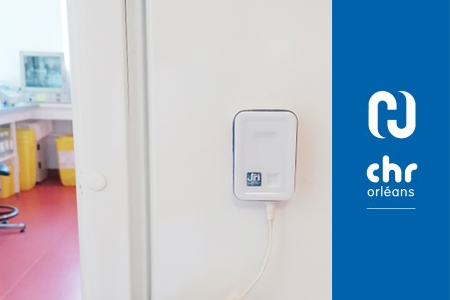
Innovate with the new generation of temperature monitoring systems
The Centre Hospitalier Régional (CHR) d’Orléans is dedicated to providing care, thanks to its high level of specialisation and ultra-modern, high-performance technical facilities.
With more than 1,700 beds and places, it had to cope with a high volume of activity in 2021: almost 100,000 emergency room visits and 5,000 births, which illustrates the variety of its care offering and therefore its pre-eminent position within the region. 5,400 people work there every day, and as a teaching and research centre, it has 89 new externally-promoted clinical trials and 179 in-house trials.
The Labguard environmental parameter monitoring system had been in place for several years at the Orléans Regional Hospital Centre. It enabled the Metrology and Quality teams to monitor all the temperature-controlled equipment in which various heat-sensitive biological and medical products, reagents, etc. are stored.
When bioMérieux announced that the Labguard solution would cease to be marketed in December 2022, the hospital’s Metrology and Quality teams took a proactive approach to anticipate the organisational, economic and Quality consequences. They opted for a long-term installation that offered scope for future development and migrated the 325 measurement points to the JRI-MySirius IoT solution.
Step-by-step transition to an iso-functional solution for temperature monitoring
In November 2021, the Nano SPY mini connected temperature sensors will be deployed in the Hygiene and PMA departments. These will “cohabit” with almost thirty Labguard 2 radio transmitters.
The laboratory’s ambient conditions, refrigerators, freezers and cold rooms are monitored by Nano SPY T2 mini temperature recorders. The ovens have a model calibrated specifically for the +30°C to +50°C temperature range. Finally, freezers at -80°C are equipped with Nano SPY T3 low-temperature recorders.
The measurements recorded by each Nano SPY are automatically transmitted to the Nano SPY LINK modules and then uploaded to the JRI-MySirius cloud-based supervision and operating platform.
“The Nano SPY mini temperature recorders communicate perfectly and have the advantage of a long battery life. When it’s time to replace the battery, JRI will do it as part of our maintenance contract.
Cédric Delapierre – Metrology Manager
Getting to know the JRI-MySirius continuous monitoring system
The first phase involved familiarising users with the new JRI-MySirius application, its interface and its Plans, Maintenance and Metrology modules, which have been designed to enable each user profile to become more efficient in their day-to-day activities.
Following its success, almost 230 measuring points are now following suit. The Biopathology Unit, Pharmacy and many other departments, as well as sites within the Gien and Pithiviers hospitals, will be added to the fleet in 2022.
“We quickly found our feet with the JRI-MySirius application, as there are a number of similarities with the Labguard software. It’s intuitive to use and more of our technicians are logging on. From a hardware point of view, we also like the fact that the Nano SPY LINK’s luminous banner warns of an alarm in progress. This allows us to be even more responsive when dealing with alarms.
Cédric Delapierre – Metrology Manager
The relationship of trust that exists between the CHR teams and JRI means that dialogue can be opened up on potential developments to provide users with even greater management convenience.
Controlling Labguard 3D temperature data loggers
The temperature recorders used by the CHR are a mix of Labguard 2 and Labguard 3D models. Working closely with the bioMérieux teams and drawing on its experience as a manufacturer of monitoring solutions compatible with older-generation software, JRI developed the software to enable the Labguard 3D measuring devices to be controlled from the JRI-MySirius application. As a result, more than seventy Labguard 3D recorders have been added to the measurement points already monitored by the new application.
Migrate historical data securely
The final phase consists of migrating all the data from the Labguard system to the JRI-MySirius application. A preparatory meeting was held between the Labguard representative at JRI and the IT and metrology managers at the Orléans Regional Hospital Centre. They agreed on the technical prerequisites to be validated beforehand: creation of a file listing all the measurement channels with the serial number of each device, opening of the computer ports, installation of compatible Labguard software versions, validation of the computer network operating system, etc.
The Labguard Referent returns to the site to carry out the final migration. Within 3 hours, the data from each Labguard device is recovered and the data from the Labguard 2 devices is linked to that of the associated Nano SPY. Everything is archived in the JRI-MySirius application without any loss of data. Temperature curves are continuous and transition information is added. The now obsolete Labguard 2 radio transmitters are then dismantled.
Support from start to finish
JRI is also responsible for maintaining the installation. This includes access to the hotline for the 205 users, a3-year warranty extension for the Nano SPY temperature recorders and battery replacement. Theprobes will be calibrated by the mobile unit of JRI’s Cofrac-accredited metrology laboratory, Lab’express.
The Orléans Regional Hospital used the UGAP contract, for which JRI is listed as the incumbent supplier, to monitor the thermostatic chambers. As a result, the central purchasing group facilitated administrative, commercial and legal procedures.


